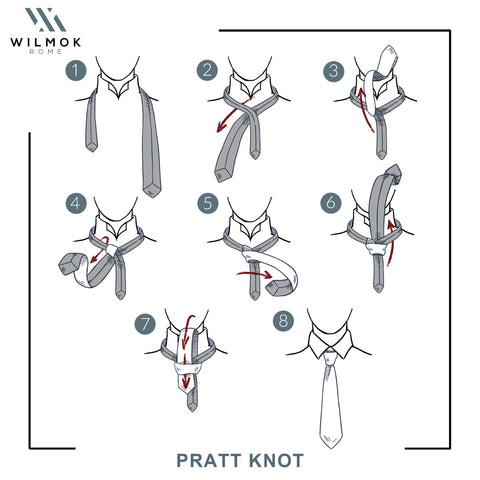Most essential, stylish and easy tie knots for 2025
Here is a simple and practical guide to tie a tie in the most Dapper ways -
1. SIMPLE KNOT / ORIENTAL KNOT
The classic knot: simple, fast and efficient, especially for those mornings when you're late and have no time to waste. While you're having a quick breakfast your espresso and bagel, put on the tie with the pattern facing you and with a few simple steps you have tied the tie. Now let's get to work! Recommended for Seven fold ties.

2. FOUR IN HAND KNOT
This knot is just as simple with the only difference being that the tie is facing outwards and therefore requires an extra step.
Fast and elegant. Recommended for Grenadine ties.

3. WINDSOR KNOT
We tiptoe into Buckingham Palace and introduce you to the knot favoured by Duke Edward of Windsor, the future King Edward VIII of the United Kingdom (the one who later abdicated to marry the divorced American, if you've seen The Crown on Netflix, you know who we're talking about).
The knot became famous in the 1930s when Edward of Windsor, whose style and elegance were a trend in men's fashion, began to prefer rather voluminous knots.
But it was not the Duke who invented the knot, although it bears his name; in fact it is said that he did not even wear it. The Windsor knot was likely invented to emulate the Duke's wide knots using ties of normal thickness. The paternity of the knot seems more likely to belong to Domenico Scappino, so much so that more than a few call it the Scappino knot ... but we think the Windsor knot sounds better, by far!
The Windsor knot, compared to other methods of tying the tie, if done well allows the creation of a large, triangular and perfectly symmetrical knot. Its realisation involves eight steps and the use of a long tie is therefore indicated. Generally the Windsor knot is considered suitable for more formal occasions and in fact is probably the best tie knot for weddings. It is considered the standard model for tying ties in the Italian military world.

4. HALF WINDSOR KNOT
If you do not have a long tie, but prefer a more voluminous knot than usual, we present the Half Windsor knot suitable for medium length ties but still maintains the style and elegance of the Windsor knot. The Half Windsor is also generally considered to be the best tie knot for an interview. There are 9 steps and it does not require a particular skill, but only practice.

5. PRINCE ALBERT KNOT
Remaining in house Windsor, we go back a bit to Queen Victoria and are introduced to the Prince Albert knot, a variation of the Victoria knot.
There is no evidence to suggest that the knot was actually worn by its namesake, Prince Albert, husband of Queen Victoria. This knot is slightly asymmetrical but has a little more volume than the Four-in-Hand, it is recommended to tighten it well to give it a slim and elegant look. Recommended for Shantung ties.

6. PRATT KNOT
It's also known as the Shelby and Pratt-Shelby knot (no, not THE Shelby from Peaky Blinders). The knot was created by Jerry Pratt, an employee of the American Chamber of Commerce in the late 1950s. It became popular as a Shelby knot after Pratt, then 92, decided to teach it to television reporter Don Shelby.
The Pratt knot is unusual in that its starting position is "flipped out", like the simple knot. The length of the tie should be shorter than Windsor and half Windsor knots, so it is suitable for shorter ties or taller men. Unlike the four hand knot, the Pratt method produces a symmetrical knot and is not very thick.



0 Comments
There are no comments for this article. Be the first one to leave a message!